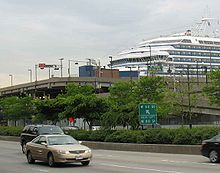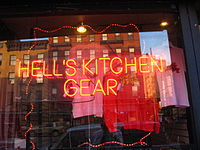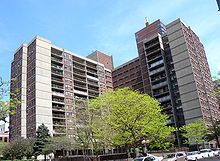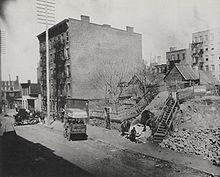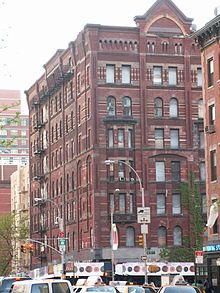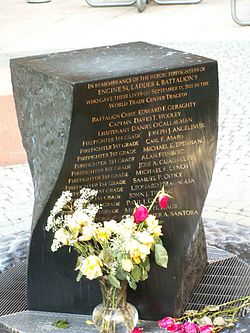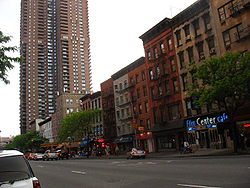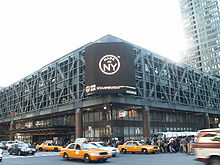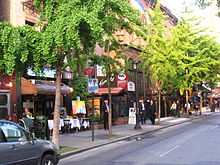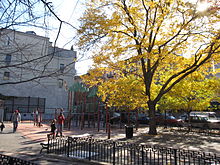- Hell's Kitchen, Manhattan
-
This article is about the neighborhood in Manhattan. For other uses, see Hell's Kitchen (disambiguation).
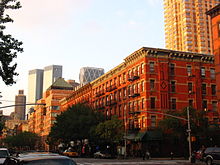 View from between 47th and 48th streets on Ninth Avenue looking northeast toward Time Warner Center and Hearst Tower
View from between 47th and 48th streets on Ninth Avenue looking northeast toward Time Warner Center and Hearst Tower
Hell's Kitchen, also known as Clinton and Midtown West, is a neighborhood of Manhattan in New York City between 34th Street and 59th Street, from 8th Avenue to the Hudson River.[1]
The neighborhood provides transportation, hospital and warehouse infrastructure support to the Midtown Manhattan business district. Its gritty reputation depressed real estate prices in the area relative to much of the rest of Manhattan until the early 1990s. Since then, rent prices have increased enormously, with current rent prices above the Manhattan average.[2]
The rough and tumble days on the West Side figure prominently in Damon Runyon's stories and the childhood home of Marvel Comics' Daredevil. Various Manhattan ethnic conflicts formed the basis of the musical and film West Side Story.
Once a bastion of poor and working-class Irish Americans, over the last three decades of the 20th century and into the new millennium, Hell's Kitchen has undergone change as a result of its proximity to Midtown. The 1969 edition of the Plan for New York City book authored by the City Planning Commission stated that people of modest means were being driven from the area by development pressures due to the Midtown location. Today, many actors reside in the neighborhood because it is near the Broadway theaters and Actors Studio training school.
Contents
Geography
"Hell's Kitchen" generally refers to the area from 34th to 59th streets. Starting west of 8th Avenue, city zoning regulations limit buildings to 6 stories high (although exceptions are often made). As a result, most of the buildings are older, often walk-ups. For the most part the neighborhood encompasses the ZIP codes 10019 and 10036. The post office for 10019 is called Radio City Station, the original name for Rockefeller Center on Sixth Avenue.
- Southern boundary: Hell's Kitchen and Chelsea overlap and are often lumped together as the West Side since they support the Midtown Manhattan business district. The traditional dividing line is 34th Street. The transition area just north of Madison Square Garden and Pennsylvania Station includes the Jacob K. Javits Convention Center.
- Eastern boundary: The neighborhood overlaps the Times Square theater district to the east at Eighth Avenue. On its southeast border, it overlaps the Garment District also on Eighth Avenue. Here, two landmarks reside - the New Yorker Hotel and the dynamic Manhattan Center building (at the northwest corner of 34th Street and Eighth Avenue). Included in the transition area on Eighth Avenue are the Port Authority Bus Terminal at 42nd Street, the Pride of Manhattan Fire Station (from which 15 firefighters died at the World Trade Center), several theaters including Studio 54, the original soup stand of Seinfeld's Soup Nazi, and the Hearst Tower.
- Northern boundary: The neighborhood edges toward the southern boundary of the Upper West Side, and 57th Street is considered by some the traditional northern boundary. However the neighborhood often is considered to extend to 59th Street (the southern edge of Central Park starting at Eighth Avenue) where the avenue names change. Included in the 57th to 59th Street transition area are the Time Warner Center at Columbus Circle, St. Luke's-Roosevelt Hospital Center, where John Lennon died in 1980 after being shot, and John Jay College.
- Western boundary: The western boundary is the Hudson River.
Name
Several explanations exist for the original name. An early use of the phrase appears in a comment Davy Crockett made about another notorious Irish slum in Manhattan, Five Points. According to the Irish Cultural Society of the Garden City Area:
When, in 1835, Davy Crockett said, '"In my part of the country, when you meet an Irishman, you find a first-rate gentleman; but these are worse than savages; they are too mean to swab hell's kitchen." He was referring to the Five Points.[3]
According to an article by Kirkley Greenwell, published online by the Hell's Kitchen Neighborhood Association:
No one can pin down the exact origin of the label, but some refer to a tenement on 54th Street as the first "Hell's Kitchen." Another explanation points to an infamous building at 39th as the true original. A gang and a local dive took the name as well.... a similar slum also existed in London and was known as Hell's Kitchen.[4]
Local historian Mary Clark adds a probably apocryphal anecdote when she states the name:
...first appeared in print on September 22, 1881 when a New York Times reporter went to the West 30s with a police guide to get details of a multiple murder there. He referred to a particularly infamous tenement at 39th Street and 10th Avenue as "Hell's Kitchen," and said that the entire section was "probably the lowest and filthiest in the city." According to this version, 39th Street between 9th and 10th Avenues became known as Hell's Kitchen and the name was later expanded to the surrounding streets. Another version ascribes the name's origins to a German restaurant in the area known as Heil's Kitchen, after its proprietors. But the most common version traces it to the story of Dutch Fred The Cop, a veteran policeman, who with his rookie partner, was watching a small riot on West 39th Street near 10th Avenue. The rookie is supposed to have said, "This place is hell itself," to which Fred replied, "Hell's a mild climate. This is Hell's Kitchen."[5]
Alternative names
Hell's Kitchen has stuck as the general and informal name of the neighborhood even though real estate developers have offered alternatives of Clinton and Midtown West or even "the Mid-West". The Clinton name, used by the municipality of New York City, originated in 1959 in an attempt to link the area to DeWitt Clinton Park at 52nd and 11th Avenue, named after the 19th century New York governor.
History
On the island of Manhattan as it was when Europeans first saw it, the Great Kill (Dutch: Grote Kil, Middle Dutch: Groote Kille), which formed from three small streams that united near 10th Avenue and 40th street, wound through the low-lying Reed Valley renowned for fish and waterfowl[6] to empty into the Hudson River at a deep bay on the river at the present 42nd Street.[7] The name was retained in a tiny hamlet, Great Kill, that became a center for carriage-making, as the upland to the south and east became known as Longacre, the predecessor of Longacre, now Times Square.[8] One of the large farms of the colonial era in this neighborhood was that of Andreas Hopper and his descendants; it spanned the distance between today's 48th Street nearly to 59th Street and stretched from the river east to what is now Sixth Avenue. One of the Hopper farmhouses, built in 1752 for John Hopper the younger, stood near 53rd Street and 11th Avenue; christened "Rosevale" for its extensive gardens, it was the home of the War of 1812 veteran, Gen. Garrit Hopper Striker, and lasted until 1896, when it was demolished; the site was purchased for the city and naturalistically landscaped by Samuel Parsons Jr. as DeWitt Clinton Park. In 1911 New York Hospital bought a full city block largely of the Hopper property, between 54th and 55th Street, Eleventh and Twelfth Avenues.[9] Beyond the railroad track, projecting into the river at 54th Street, was Mott's Point, with an 18th-century Mott family house, surrounded by gardens, that was inhabited by members of the family until 1884 and survived until 1895.[10]
A lone surviving structure that dates from the time this area was open farmland and suburban villas is the carriage house (pre-1800) that once belonged to a villa owned by ex-Vice President and New York State governor George Clinton, now in a narrow court behind 422 West 46th Street.[11] From 1811 until it was officially de-mapped the ghostly Bloomingdale Square was part of the city's intended future; it extended from 53rd to 57th Streets between Eighth and Ninth Avenues. It was eliminated in 1857 after the establishment of Central Park,[12] and the name shifted to the junction of Broadway, West End Avenue, and 106th Street, now Straus Park. In 1825, for $10 the City purchased clear title to a right-of-way through John Leake Norton's[13] farm, "The Hermitage", to lay out 42nd Street clear to the river. Before long, cattle ferried from Weehawken were being driven along the unpaved route, to slaughterhouses on the East Side.[14] Seventy acres of the Leake, later Norton property, extending north from 42nd to 46th Street and from Broadway to the river, had been purchased before 1807 by John Jacob Astor and William Cutting, who held it before dividing it into building lots as the district became more suburban.
The first change that began to unite the area more closely to New York City was the construction of the Hudson River Railroad, which completed the forty miles to Peekskill on 29 September 1849, to Poughkeepsie by the end of that year, and extended to Albany in 1851. As far as 60th Street, the track ran at street grade up 11th Avenue, before the independent riverside roadbed commenced.[15]
The formerly rural riverfront was transformed for industrial uses such as tanneries that could discharge their effluent into the river and ship their production by the rails. Hence the beginnings of the neighborhood of the southern part of the 22nd Ward, which would become known as Hell's Kitchen, start in the mid-19th century, when immigrants from Ireland, most of whom were refugees from the Great Famine, began settling on the west side of Manhattan in shantytowns along the Hudson River. Many of these immigrants found work on the docks nearby, or along the railroad that carried freight into the city along 11th Avenue.
After the American Civil War the population increased dramatically, as tenements were erected and increased immigration added to the neighborhood's congestion. Many in this poverty stricken area turned to gang life and the neighborhood soon became known as the "most dangerous area on the American Continent". At the turn of the century, the neighborhood was controlled by gangs, including the violent Gopher Gang led by the notorious Owney Madden.[16]
The violence escalated during the 1920s, as Prohibition was implemented. The many warehouses in the district served as ideal breweries for the rumrunners who controlled the illicit liquor. Gradually the earlier gangs such as the Hell's Kitchen Gang were transformed into organized crime entities around the same time that Owney Madden became one of the most powerful mobsters in New York.
After the Repeal of Prohibition, many of the organized crime elements moved into other rackets, such as illegal gambling and union shakedowns. The postwar era was characterized by a flourishing waterfront, and work as a longshoreman was plentiful. By the end of the 1950s, however, the implementation of containerized shipping led to the decline of the West Side piers and many longshoremen found themselves out of work. In addition, the construction of the Lincoln Tunnel had devastated much of Hell's Kitchen to the south of 39th Street.[17]
West Side Story
During the 1950s, immigrants, notably Puerto Ricans, moved into the neighborhood. The conflict between the Irish, Italians, and the Puerto Ricans is highlighted in West Side Story. The movie was filmed from 65th Street and 69th Street between Amsterdam and West End Avenue, north of Hell's Kitchen. Part of the sites seen are old P. S. 94 on the corner of 68th Street and Amsterdam Avenue and St. Michael's Church. The movie was filmed during the demolition of this area that was to become Lincoln Center.
In 1959, an aborted rumble between rival Irish and Puerto Rican gangs led to the notorious "Capeman" murders in which two innocent teenagers were killed.
By 1965, Hell's Kitchen was the home base of the Westies, a deeply violent Irish American crew aligned with the Gambino crime family. It was not until the early 1980s that widespread gentrification began to alter the demographics of the longtime working-class Irish American neighborhood. The 1980s also saw an end to the Westies' reign of terror, when the gang lost all of its power after the RICO convictions of most of its principals in 1986.
Today Hell's Kitchen is an increasingly upscale neighborhood of actors and affluent young professionals, as well as residents from the 'old days'. It has also acquired a large diverse community as residents have moved north from Chelsea.
Special Clinton district
Although the neighborhood is immediately west of New York's main business district, development lagged for more than 30 years because of strict zoning rules called the Special Clinton District designed to protect the neighborhood's low-rise character.
When the third incarnation of Madison Square Garden at 50th and Eighth Avenue was torn down in 1968, New York developed a master plan calling for two to three thousand hotel rooms, 25,000 apartments, 25,000,000 square feet (2,300,000 m2) of office space, and a new super liner terminal in the neighborhood, which it described as "blocks of antiquated and deteriorating structures of every sort." During this time a proposal was made to build the world's tallest building on the Madison Square Garden site and a massive convention center at 44th Street and the Hudson River.
The District severely restricted development in the neighborhood for more than 20 years. The world's tallest building was not to rise and its Madison Square site was to remain a parking lot until 1989.
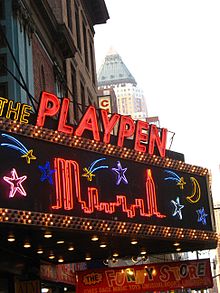 Eighth Avenue was once lined with porn stores and theaters. The stores are mostly gone now, but this particular store was highlighted in the 2003 film, Phone Booth. Worldwide Plaza is in the background. This store was torn down in December 2007.
Eighth Avenue was once lined with porn stores and theaters. The stores are mostly gone now, but this particular store was highlighted in the 2003 film, Phone Booth. Worldwide Plaza is in the background. This store was torn down in December 2007.
Provisions of the District:
The SCD was originally split into four areas:
- Preservation Area: 43rd to 56th Streets between 8th and 10th Avenues. R-7 density, 6-story height limit on new buildings, suggested average apartment size of two bedrooms (this was a response to the fact that between 1960 and 1970 developers had torn down 2,300 family-sized units and replaced them with 1,500 smaller units).
- Perimeter Area: 8th Avenue, 42nd and 57th Streets. Bulkier development permitted to counterbalance the downzoning in the preservation area.
- Mixed Use Area: 10th and 11th Avenues between 43rd and 50th Streets. Mixed residential and manufacturing. New residential development only permitted in conjunction with manufacturing areas.
- Other Areas: West of 11th Avenue. Industrial and waterfront uses.
The mixed use area and other area are now combined into "Other areas."
Building height in the Preservation Area cannot exceed 66 feet (20 m) or seven stories, whichever is less.
Special permits are required for all demolition and construction in the SCD, including demolition of "any sound housing in the District" and any rehabilitation that increases the number of dwellings in a structure. New developments, conversions, or alterations that create new units or zero bedroom units must contain at least 20% two bedroom apartments with a minimum room size of 168 square feet (16 m2). Alterations that reduce the percentage of two bedroom units are not permitted unless the resulting building meets the 20% two bedroom requirement.
In the original provisions no building could be demolished unless it was unsound.
Windermere
As the gentrification pace increased, there were numerous reports of problems between landlords and tenants. The most extreme example was the eight story Windermere complex at the southwest corner of Ninth Avenue and 57th Street—two blocks from Central Park.[18]
Built in 1881, it is the second-oldest large apartment house in Manhattan. All the major New York newspapers covered the trials that sent the Windermere's managers to jail. According to former tenants and court papers, rooms were ransacked, doors were ripped out, prostitutes were moved in, and tenants received death threats in the campaign to empty the building. Its landlord Alan B. Weissman made top billing in the 1985 edition of The Village Voice annual list, "The Dirty Dozen: New York's Worst Landlords, surpassed only by Traill." He too was never convicted of anything.
Most of the tenants eventually settled and moved out of the building. As of May 2006, seven tenants remained and court orders protecting the tenants and the building allowed it to remain in derelict condition even as the surrounding neighborhood was experiencing a dramatic burst of demolition and redevelopment. Finally, in September 2007, the fire department evacuated those remaining seven residents from the building citing dangerous conditions and padlocked the front door.[19] In 2008 the New York State Supreme Court ruled that the owners of the building, who include the Toa Construction Company of Japan, must repair it.[20]
September 11th, 2001
While almost all fire stations in Manhattan lost firefighters in the September 11, 2001 terrorist attacks, the hardest hit station was Engine 54, Ladder 4, Battalion 9 at 48th Street and Eighth Avenue, which lost 15 firefighters. Given its proximity to Midtown, the station had specialized in skyscraper fires and rescues and in 2007 was the second busiest firehouse in New York City, with 9,685 runs between the two companies.[21]
Its patch reads "Pride of Midtown" and "Never Missed a Performance". Memorials dot the station's exterior walls and a granite memorial is in a park to its north.
Also Ladder 21, the "Pride of Hell's Kitchen", located on 38th Street between 9th and 10th Avenues, and stationed with Engine 34, lost 7 firefighters on September 11. In addition, on September 11, Engine 26 was temporarily stationed with Engine 34/Ladder 21 and lost many firefighters themselves.
Developer Larry Silverstein made part of his fortune that eventually earned him the lease for the World Trade Center by building and managing buildings in the neighborhood. Silverstein's architect David Childs who is designing the Freedom Tower designed the Time Warner Center and Worldwide Plaza buildings in the neighborhood. Signature features of those towers are slated for the Freedom Tower.
Boom times
Zoning has long restricted the extension of Midtown Manhattan's skyscraper development into Hell's Kitchen. The David Childs designed Worldwide Plaza established a beach head when it was built in 1989 at the former Madison Square Garden site, a full city block between 49th and 50th Streets and between Eighth and Ninth Avenues.
The city under Michael Bloomberg relaxed zoning all over the city in the wake of the September 11 attacks. This led to a real-estate building boom with Hell's Kitchen getting some of the biggest projects in the city including the Hearst Tower at 56th Street and Eighth Avenue.
An indication of how fast the neighborhood became hot was a 2004 transaction involving the Howard Johnson's Motel at 52nd and Eighth Avenue. In June, Vikram Chatwal's Hampshire Hotel Group bought the motel and adjoining SIR (Studio Instrument Rental) building for $9 million. In August, they sold the property to ElAd Properties for about $43 million. Elad, which owns Plaza Hotel, is in the process of building The Link, a luxury 44-story building.
Actors' neighborhood
Hell's Kitchen's gritty reputation has made its housing prices lower than elsewhere in Manhattan. Given the lower costs and its proximity to Broadway theaters, the neighborhood is a haven for aspiring actors. Many famous actors and entertainers have resided there, including Burt Reynolds, Rip Torn, Bob Hope, Charlton Heston, James Dean, Madonna, Jerry Seinfeld, Larry David, Alicia Keys, John Michael Bolger, and Sylvester Stallone. This is due in large part to the Actors Studio on West 44th, which rose to prominence under Lee Strasberg and is famed for its method acting style.
With the opening of the original Improv by Budd Friedman in 1963, the club became a hangout for singers to perform but quickly attracted comedians, as well, turning it into the reigning comedy club of its time. Located on West 44th near the SE corner of 9th Ave, it has since shuttered, replaced by a restaurant.
Manhattan Plaza at 42nd Street between Ninth and Tenth Avenues was built in the 1970s to house artists. It consists of two 46-story towers with 70 percent of the apartments set aside for performing artists. The Actors Temple and Saint Malachy's Roman Catholic Church with its Actors' Chapel also testify to the long-time presence of show business people.
The neighborhood is also home to a number of broadcast and music-recording studios, including the CBS Broadcast Center at 524 West 57th Street (also the home of Black Entertainment Television's 106 & Park show), Sony Music Studios at 460 West 54th Street, Manhattan Center Studios at 311 West 34th Street, and Right Track Recording's Studio A509 orchestral recording facility at West 38th Street and 10th Avenue. The syndicated Montel Williams Show is also taped locally at the Unitel Studios, 433 W. 53rd Street, between Ninth and Tenth Avenues.
Comedy Central's satirical program The Daily Show is also taped in Hell's Kitchen. In the summer of 2005, it moved from its quarters at 54th Street and 10th Avenue to a new studio in the neighborhood, at 733 11th Avenue, between 51st and 52nd Streets. The old location at 54th and 10th is now home to The Colbert Report.
Next door to Colbert at 511 W. 54th St. is Ars Nova Theater, home to emerging artists Joe Iconis and breakout star Jesse Eisenberg, among others.
The headquarters of Troma studios is located in Hell's Kitchen.
The Alvin Ailey American Dance Theater opened at 55th Street and Ninth Avenue in 2006.
The Clinton Community Garden is a result of the actors living in the area. Since they mostly work at night in the local theaters, they took time to create a garden in a rubble-strewn lot. Eventually it became a selling point for gentrification, providing real estate agents with another selling point.
Transportation center
About every conceivable form of transportation, including horses, ocean going ships, and airplanes, has some form of infrastructure in the neighborhood.
- Automobiles - The Lincoln Tunnel connects New York City to New Jersey. Parking lots dot the neighborhood. Eleventh Avenue is lined with car dealerships, many of which claim to have the highest volume among all dealerships for their brands in the country.
- Buses - The massive Port Authority Bus Terminal is between 40th and 42nd Streets and 8th and 9th Avenues.
- Horses - Many of the horse drawn carriages from Central Park stay in stables just off the West Side Highway. It is not uncommon to hear the clip clop of horses in the neighborhood. There have been calls for banning horse-drawn carriages following a handful of collisions between cars and carriages. The carriage horses live in historic stables originally built in the 19th century, but today boast the latest in barn design, such as fans, misting systems, box stalls, and state of the art sprinkler systems. As horses always have in densely populated urban areas, the carriage horses live upstairs in their stables while the carriages are parked below on the ground floor.
- Planes - An assortment of planes including the Concorde and Lockheed A-12 are on display at the Intrepid Sea-Air-Space Museum located at Pier 86 at 46th Street.
- Ships - Cruise ships frequently dock at the New York Passenger Ship Terminal in the 48th to 52nd piers called Piers 88, 90, 92. Cruise ship horns are a common sound in the neighborhood. Several French restaurants opened on West 51st Street to accommodate traffic from the French Line. The piers originally built in 1930 are now considered small, and some cruise traffic uses other locations.
- In addition to the passenger ships, the Intrepid Sea-Air-Space Museum features the USS Intrepid (CV-11) Aircraft Carrier as well as an assortment of submarines and destroyers. Other ship operations in the neighborhood include Circle Line Sightseeing Cruises at West 42nd and the NY Waterway ferry service.
- Trains - Hell's Kitchen begins northwest of Penn Station. Amtrak trains going into the station run along a sunken corridor west of 10th Avenue. It is not uncommon to hear their train whistles in the neighborhood. During the post-9/11 building boom, apartment houses have been built over sections of the train tracks. Hell's Kitchen is bounded on the east by the Eighth Avenue subway line, the westernmost NYC subway line in Midtown. The MTA is extending the Flushing Line west from its current terminus at Times Square to the Jacob K. Javits Convention Center at 34th Street and 11th Avenue.
Food diversity
Ninth Avenue is noted for its many ethnic restaurants. The Ninth Avenue Association's International Food Festival, stretches through the Kitchen from 37th to 57th Streets every May, usually on the third weekend of the month. It has been going on since 1974 and is one of the oldest street fairs in the city. In addition to the usual American[clarification needed], Caribbean, Chinese, French, German, Greek, Italian, Irish, Mexican and Thai restaurants, there are multiple Afghan, Argentine, Ethiopian, Peruvian, Turkish, Indian, Pakistani and Vietnamese restaurants. Restaurant Row is located on West 46th Street between Eighth and Ninth Avenues.
Parks
Hell's Kitchen's side streets are mostly lined with trees. The neighborhood does not have many parks or recreational area though, but smaller plots that were converted into green spaces. One of them is Hell's Kitchen Park.
Novels based in Hell's Kitchen
Novels based in Hell's Kitchen include:
- Daredevil (2003) by Mark Steven Johnson
- Bringing Out the Dead (1999) Joe Connelly
- Fortunate Pilgrim (1964) by Mario Puzo
- Devil's Heaven (1995) by Thomas Adcock
- Payback (1997) by Thomas Kelly
- Everybody Dies (1998) by Lawrence Block
- A Fugue in Hell's Kitchen (2004) by Hal Glatzer
- Mafia Summer (2005) by E. Duke Vincent
- Family Matters (2006) by Ira Berkowitz
- Old Flame (2008) by Ira Berkowitz
- Sinners' Ball (2009) by Ira Berkowitz
- Shamrock Alley (2009) by Ronald Malfi
- Sleepers (1995) by Lorenzo Carcaterra
- The Nero Wolfe series of novels and short stories by Rex Stout.
- Run for your life by James Patterson & Michael Ledwidge
- Deadly Shamrocks (2010) by J.B. Reed
- The Spy (2010) by Clive Cussler
- "The City of Dreams" (2010) by William Martin
Notable current and former residents
Notable current and former residents of Hell's Kitchen include:
- Benjamin Appel (1907–1977), crime novelist.[22]
- George Cain (1943–2010), author of Blueschild baby.[23]
- Vanessa Carlton (born 1980), singer / songwriter.[24]
- Larry David (born 1947), actor / producer of Seinfeld and Curb Your Enthusiasm.[25]
- Alicia Keys (born 1981), singer and pianist.[26]
- Kenny Kramer (born 1943), lived in a Hell's Kitchen apartment across the hall from Larry David and became the inspiration for the Cosmo Kramer character on Seinfeld.[25]
- Brian Mullen (born 1962), played in the NHL for the Winnipeg Jets, New York Rangers, San Jose Sharks and New York Islanders.[27]
- Joe Mullen (born 1957), played in the NHL for the St. Louis Blues, Calgary Flames, Pittsburgh Penguins and Boston Bruins from 1980–1997, winning three Stanley Cups.[27]
- Jerry Orbach (1935–2004), actor.[28]
- Ilka Tanya Payán (1943–1996), Dominican-American actress and AIDS activist
- Mario Puzo (1920–1999), author of The Godfather.[29]
- George Raft (1895–1980), actor best known for his portrayal of tough guys and gangsters.[30]
- Mickey Rourke (born 1953), actor.[31]
- Political figure Boss Tweed - West 51st Street.
- Boxer James J. Braddock ("Cinderella Man") - West 48th, just a few blocks from the Madison Square Garden venue where he fought.
- Actor and comedian Chevy Chase
- Actress Alice Faye
- Singer Tony Orlando
- Musician Robert Fripp
- Actor Robert De Niro
- Actor Stephen Blackehart
- Basketball player Joakim Noah
- Actor Sylvester Stallone
- Actor Andrew Rannells
- Singer Lisa Velez of Lisa Lisa and Cult Jam
- Actor James Cagney was raised in Hell's Kitchen but was born in Yorkville, on the other side of Manhattan.
- Illusionist and endurance artist David Blaine lived in Hell's Kitchen for several years.
- Author and filmmaker James Gunn lived in Hell's Kitchen.
- Writer and comic book artist Frank Miller
- Comic Lewis Black
- Actor Zach Galligan
- Actor Jake T. Austin
- Actor Josh Peck was born in Hell's Kitchen. He grew up there but moved to Los Angeles when he was 14 to pursue his acting career after being offered a role by Nickelodeon.
- Actor Paul Cavonis was born and raised in Hell's Kitchen; his mother still resides there.
- Actor George Maharis lived in the West 40s.
- Musician Stephan Jenkins of Third Eye Blind
- Actor Tom Hanks had an apartment in Hell's Kitchen in the late 1970s/early 80s.
- Actor Charlton Heston worked as a model in Hell's Kitchen from 1944 to 1947.
- Author Lorenzo Carcaterra was born and raised in Hell's Kitchen. The neighborhood is featured in his autobiographical story "A Safe Place" as well as the novel and later film Sleepers.
- The southern opening of the Amtrak tunnel known as the Freedom Tunnel is in Hell's Kitchen. The former "shantytowns" constructed by homeless people, now cleared, gave rise to the urban legend of Mole People, as seen in the documentary Dark Days and in Jennifer Toth's book The Mole People: Life in the Tunnels Beneath New York.
- Musician Tim Rose lived on West 46th street, Restaurant Row, in Hell's Kitchen for a decade or more in the 1980s and 90s, and later referred to it as "skid row" in a song called "Because You're Rich."
- "Typhoid Mary" (Mary Mallon) shared an apartment in Hell's Kitchen with her boyfriend between jobs as a cook during the 1900s.
- Author John Reed
- Professional wrestler Matt Wiese, known as Horshu or Luther Reigns
- Professional wrestler Mark LoMonaco, known as Bully Ray, formerly Bubba Ray Dudley
- Actor John Goodman lived on Ninth Avenue
- Comedian Graham Norton owns property on Tenth Avenue
- Actor Bruce Willis lived in the West 40's between Ninth and Tenth Avenues
- NHL player and New York Rangers Goaltender Henrik Lundqvist
- Comedian, radio personality, and musician Richard Christy
- Actor Donald Faison
- Church of Satan head, High Priest Peter H. Gilmore.
- Basketball Player Carmelo Anthony
- Robb Nunzio (born 1963) - Founding member & guitarist of famed NYHC band Antidote
- Chef and Author Anthony Bourdain [32]
Hell's Kitchen mobsters
- Bill Dwyer
- Owney Madden
- Vincent "Mad Dog" Coll
- Eddie McGrath
- Mickey Spillane
- Edward Cummiskey
- Tom Devaney
- James Coonan
- Mickey Featherstone
References
- ^ Benson, Michael R. "CLINTON FRETS OVER THAT GLEAM IN DEVELOPERS' EYES", The New York Times, December 22, 1985. Accessed February 17, 2008. "Hell's Kitchen, which stretched from 40th to 59 Streets and from Eighth Avenue to the Hudson, is now called Clinton. The modern district reaches south to 34th Street."
- ^ "Manhattan Rental Market Report". http://www.mns.com/manhattan_rental_market_report#midtown-west.
- ^ Walsh, John (September 1994). "The Five Points". © Irish Cultural Society of the Garden City Area. http://www.irish-society.org/Hedgemaster%20Archives/five_points.htm. Retrieved 2009-03-12.[dead link]
- ^ Greenwell, Kirkley. "Hell's Kitchen Neighborhood Association". HKNA Official website. World Wide Vibe.com. http://www.hknanyc.org/hood.html. Retrieved 2009-03-12.
- ^ Klara Madlin Real Estate Inc.. "Clinton/Hell's Kitchen". http://www.klaramadlin.com/internatLINKS/neighborhoods/clinton.asp. Retrieved 10 January 2009.
- ^ Gerard T. Koeppel, Water for Gotham: A History, 2001:10.
- ^ Eric W. Sanderson, Mannahatta: A Natural History of New York City, 2009: Appendix A p 253; refs. G.E. Hill and G.E. Waring Jr, "Old wells and water-courses on the isle of Manhattan", in Historic New York, M.W. Goodwin, A.C. Royce, and R. Putnam, 1897; and others.
- ^ Edwin G. Burrows and Mike Wallace, Gotham: A History of New York City to 1898, 1999:721.
- ^ "New hospital home on old Hopper farm", The New York Times, 12 March 1911 accessed 18 April 2010.
- ^ Dates and details as given in New York's New Up-town Centre; Long Acre Square of To-day and Yesterday", The New York Times, 21 September 1902 accessed 18 April 2010.
- ^ The address is "Clinton Court", 422½ West 48th Street; illustrated in Kevin Walsh, Forgotten New York: The Ultimate Urban Explorer's Guide to All five Boroughs 2006:176.
- ^ Gilbert Tauber , "Old Streets of New York": "B" Streets.
- ^ Norton, the great-nephew of John Leake, founder of Leake and Watts Children's Home, is listed among early 19th-century owners of considerable tracts in what is now Hell's Kitchen, with John Jacob Astor, William Cutting, Thomas Addis Emmet, Andrew Hopper, John Horn and William Wright, in New York's New Up-town Centre; Long Acre Square of To-day and Yesterday", The New York Times, 21 September 1902 accessed 18 April 2010.
- ^ Ken Bloom, Broadway: its history, people, and places : an encyclopedia, "Introduction",2004 :xiii.
- ^ Bradbury and Guild, The Hudson River and the Hudson River Railroad, 1851.
- ^ Bayor, Ronald H. and Meagher, Timothy J. (1997). The New York Irish, pp. 217-18. JHU Press. ISBN 0801857643.
- ^ English, T.J. (2006). The Westies: Inside New York's Irish Mob, p. 39. Macmillan. ISBN 0312362846.
- ^ NYC Landmark report
- ^ NY Times Article 9/22/2007
- ^ Associated Press (May 10, 2008). "Repairs Ordered at Windermere". New York Times. http://www.nytimes.com/2008/05/10/nyregion/10windermere.html. Retrieved 2009-10-25.
- ^ FDNewYork.com Runs and Workers - 2007
- ^ Jamieson, Wendell. "CITY LORE; Hard-Boiled Tales, Told by a Gentleman", The New York Times, January 1, 2006. Accessed August 11, 2009. "BENJAMIN APPEL was an author of more than 25 novels from 1934 to 1977, many of them set in New York. He was raised in Hell's Kitchen in Manhattan and lived much of his life in Roosevelt, N.J., but after he moved he still came back to New York often."
- ^ Grimes, William. "George Cain, Writer of ‘Blueschild Baby,’ Dies at 66", The New York Times, October 29, 2010. Accessed October 31, 2010.
- ^ Staff. "Second Cup Cafe: Vanessa Carlton", CBS News, November 17, 2007. Accessed August 10, 2009. "A few years ago, this three-time Grammy nominee was living in New York's Hell's Kitchen and working as a waitress in Lower Manhattan between performances at open mic nights in the city's clubs."
- ^ a b McShane, Larry. "The real Kramer says actor no racist: But Richards is 'paranoid,' 'very wound-up'", Chicago Sun-Times, November 26, 2006. Accessed August 11, 2009. "The real Kramer lived for 10 years in a Hell's Kitchen apartment across the hall from Seinfeld co-creator Larry David, and his life became the framework for Richards' quirky, bumbling Seinfeld sidekick."
- ^ Mervis, Scott. "Music Preview: Through her first several records, Alicia Keys has a golden touch", Pittsburgh Post-Gazette, April 17, 2008. Accessed August 10, 2009. "Keys, a classically trained pianist raised in Hell's Kitchen by her Italian-Scottish mother, spent a few years after she dropped out of Columbia University trying to launch her pop career with songs on soundtracks."
- ^ a b Allen, Kevin. "Mullen brothers come long way from Hell's Kitchen", USA Today, February 7, 1989. Accessed August 11, 2009.
- ^ Brantley, Ben; Severo, Richard. "Jerry Orbach, Stage and TV Actor, Is Dead at 69", The New York Times, December 30, 2004. Accessed August 11, 2009.
- ^ Homberger, Eric. "Mario Puzo: The author of the Godfather, the book the Mafia loved", The Guardian, July 5, 1999. Accessed August 10, 2009. "Born the son of illiterate Neapolitan immigrants, and one of 12 children, Puzo grew up in Hell's Kitchen on the west side of Manhattan."
- ^ via Associated Press, "'Tough guy' George raft dies of emphysema at 85", The Milwaukee Sentinel, November 25, 1980. Accessed August 10, 2009. "After growing up in New York's tough Hell's Kitchen area, Raft was a boxer, electrician and baseball player before landing a job as a dancer in nightclubs in the 1920s."
- ^ Frankel, Bruce. "Rourke sits in on trial of pal Gotti", USA Today, March 17, 1992. Accessed August 10, 2009. "The bad-boy actor, who grew up in Hell's Kitchen in Manhattan, spent the morning in court on a 'family - the Gotti family - pass, following transcripts of conversations between Gotti, Salvatore 'Sammy Bull' Gravano and others."
- ^ "Disappearing Manhattan." Anthony Bourdain No Reservations. Travel Channel. February 23, 2009.
External links
- Clinton Community Garden
- Hell's Kitchen Neighborhood Association
- Community Board 4
- New York Magazine neighborhood profile
- Hell's Kitchen Neighborhood Business and Services Directory
Coordinates: 40°45′47″N 73°59′40″W / 40.763186°N 73.994508°W
Categories:- Neighborhoods in Manhattan
- Irish-American neighborhoods
- Ethnic enclaves in the United States
Wikimedia Foundation. 2010.

